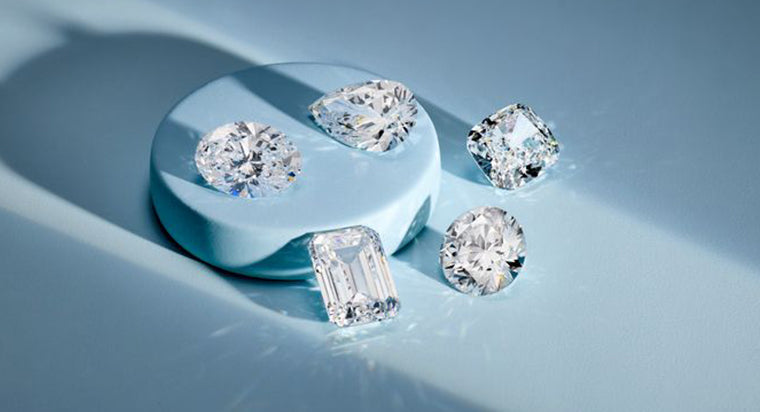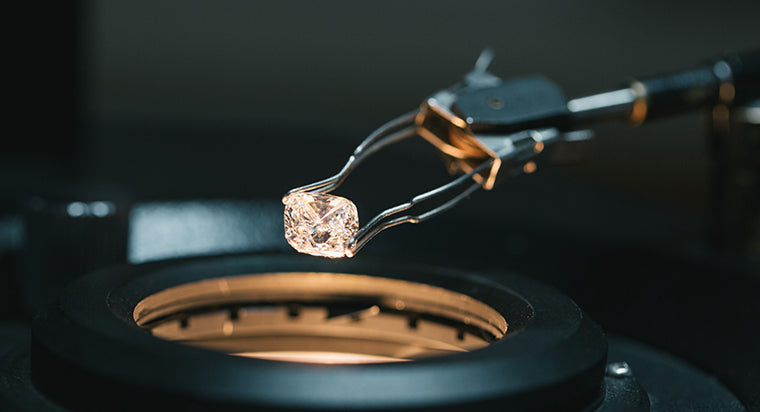What is the CVD Process to Grow Lab Diamonds?

Due to increasing popularity, nowadays more people are aware of the alternative choice of lab grown diamonds. People are also learning that these diamonds, though not naturally mined, are 100% REAL diamonds, not synthetic gemstones (e.g. cubic zirconium).
One thing that may remain a mystery to some people is how those real diamonds are “grown” in labs (or, more specifically, how it is possible to grow real diamonds in a controlled environment).
TABLE OF CONTENTS
Naturally Mined Versus Lab Grown Diamonds
It is important to first understand the difference between lab grown diamonds and those that mined from nature (diamond mines). As we mentioned above, many people have the idea that “lab grown” diamonds mean that they are fake. This is not true. Moreover, it is wrong to refer to lab diamonds as “synthetic diamonds.”
While there are notable differences between lab made and naturally mined diamonds, lab grown diamonds are just as real as those that are unearthed from mines. In short, these diamonds are exactly the same physically, chemically and visually (optically).
The biggest difference between naturally mined diamonds and lab created diamonds is that the latter is created in a controlled environment. Additionally, the process by which diamonds are formed is sped up and monitored by specialists. One of the processes these scientists follow to grow diamond seeds into man made diamonds is called CVD.
Now, for those of you who may be wondering, what is CVD? Keep reading, the answer is coming soon.
What Exactly IS the CVD Process?
First, what does CVD stand for? In regard to the formation of lab grown diamonds, CVD stands for “chemical vapor deposition” system.
The chemical vapor deposition system begins with a diamond “seed.” A diamond seed is a small natural diamond fragment that can undergo both extreme temperature and pressure conditions. Therefore, selecting the strongest and highest grade (in color and clarity) natural diamond bit is crucial for lab diamond creation.
During the CVD process, the vacuum chamber in which the diamond “seed” is placed fills with gases that are heavy in carbon and is then heated to well over 1,000 degrees. The intense heat then turns the gases into “plasma.” For those of us who do not know, the plasma is what helps “build” the layers of the diamonds, making them into the lovely gemstones that we know and love so well.
Do these create better quality diamonds?
Well, as with any diamond, the answer may vary. The best, most beautiful naturally occurring diamond can always, and at any time during the critical formation stages, be exposed to materials and/or gases that can affect its quality or any of the four C’s ( clarity, carat, color, and cut).
However, in a normal, successful completion of the CVD process, the resulting diamonds are more often even better quality than any crafted from naturally mined diamonds. In fact, they are often essentially “perfect,” diamonds.
How do the experts perform this diamond creating process?
They require the use of special CVD equipment, such as microwave technology, reactors, and even specific applications unique to the development of CVD lab diamonds. It also takes a great deal of time, as well as careful observation and control of the environment in which the lab diamonds are being formed. In the end, it is well worth it!
Are There Any Other Diamond Growing Processes?
Yes! As with many things, there is more than one way to create lab grown diamonds. The other method for creating man made diamonds is called high pressure, high temperature (HPHT). During this process, a pure source of carbon is placed under high pressure and high temperature. The extreme heat and intense pressure result in the crystallization of the carbon, which, of course, results in the formation of a brand-new diamond.
How to Know if a Lab Grown Diamond is CVD
With the naked eye, it may be difficult to tell which process was used to create your lab grown diamond. Both processes that we have discussed make the same product. Moreover, diamonds created by CVD and HPHT are just as real as any naturally mined gemstone.
However, due to the plasma that builds up to create the layers of the diamond, CVD made diamonds are often more perfect and flawless. Despite that, if a CVD lab diamond’s color needs to be improved, it can still undergo a little bit of the HPHT process.
Is the CVD Process Better?
It depends; both methods of diamond creation have their place. It all depends on what the end goal of the method used is. For instance, diamond experts who are looking to minimize the costs of their diamond growing, or if they wish to improve the color of the diamonds (either lab grown or naturally mined), they will likely use the HPHT method. If, however, the cost is no issue, and the proportions and clarity of the stone are more important, it is more probable that they will prefer CVD lab grown diamonds.
If you are unsure whether the CVD process or the HPHT process is better for your engagement ring, talk to our gemologists.
FAQs
What is the CVD process for growing Lab Diamonds?
The CVD (Chemical Vapor Deposition) process is a method used to synthesize diamond films. In this process, a mixture of gases, typically methane and hydrogen, is introduced into a chamber and heated to high temperatures (typically between 600-900°C). The gases then decompose and carbon atoms deposit onto a substrate, forming a diamond film. The process can be used to grow lab-grown diamonds on a small scale, typically used for industrial or research purposes.
What is a CVD diamond?
A CVD diamond is a diamond that is created using the Chemical Vapor Deposition (CVD) process. In this process, a mixture of gases, typically methane and hydrogen, is introduced into a chamber and heated to high temperatures (typically between 600-900°C). The gases then decompose and carbon atoms deposit onto a substrate, forming a diamond film. CVD diamonds are typically smaller and less expensive than naturally mined diamonds, and are often used in industrial and scientific applications, such as cutting tools, thermal management, and optics. They can also be used in jewelry, but are less valuable than natural diamonds.
Is there any other method to grow diamonds in a lab other than CVD?
The other method to grow diamonds in a lab is called High Pressure High Temperature (HPHT) method. This method mimics the natural process of diamond formation in the Earth's mantle by applying high pressure and high temperature to a small seed crystal of diamond, and a carbon source material (usually graphite). The carbon atoms in the graphite are rearranged into a diamond lattice around the seed crystal, and the diamond grows layer by layer. The HPHT method can be used to grow large, high-quality diamonds that are similar to natural diamonds in terms of appearance and physical properties. Both CVD and HPHT methods are used to produce lab-grown diamonds, and are considered as alternatives to natural diamonds.
Are CVD diamonds real?
Yes! CVD diamonds are 100% with the same physical, chemical, and optical characteristics as earth-mined diamonds.









